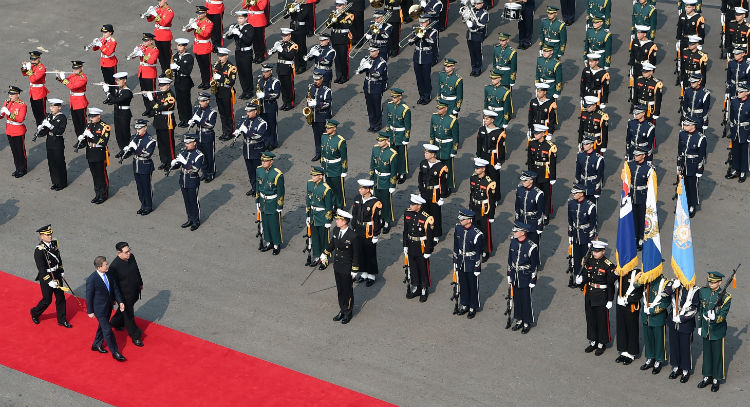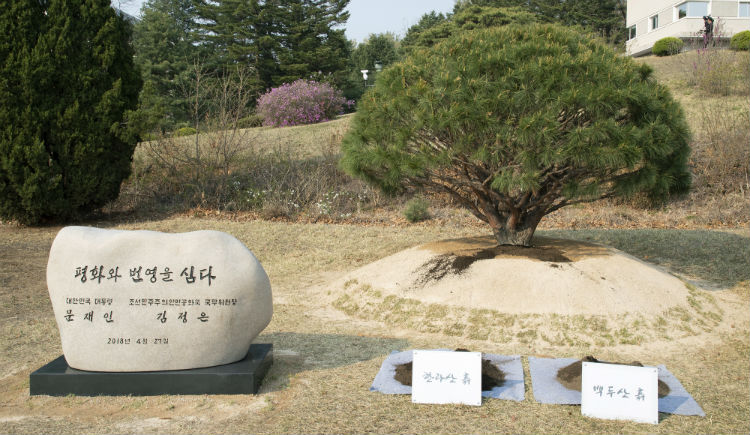April 27, 2018 “Peace, a New Start”
The 1st Inter-Korean Summit April 2018
“We will not regress.”
“Chairman Kim finally crossed into the South. When will I be able to cross into the North?” "Why don't we cross the line together right now?”
For the first time since the Korean War, the supreme leader of North Korea stepped into the southern side of Panmunjeom. The leaders of the two Koreas crossed the Military Demarcation Line hand-in-hand. They walked together along the Footbridge like two close friends and declared the start of a new era of peace, standing side-by-side. Each and every movement of their meeting was broadcast live around the world. Viewers everywhere were pleasantly surprised and deeply moved.
Timeline of the Summit

01 Outcomes
and Significance
Stepping Stone for the Peace on the Korean Peninsula
The first and most important outcome of the April 2018 Inter-Korean Summit is that it laid the groundwork for the sustainable development of the inter-Korean relationship.
The two leaders agreed to stringently comply with all agreements reached by the two sides. They came up with measures to ensure their implementation and thereby to guarantee the irreversible advancement of the inter-Korean relationship. In particular, the two leaders agreed to seek solutions through dialogue and negotiations, and pledged to hold talks about various topics, including high-level talks. It was also agreed that the two sides would increase the number of exchanges and push overall cooperation, all to promote mutual understanding and the common interests of both the South and the North. More specifically, the two sides agreed to hold family reunions on the occasion of National Liberation Day, Aug. 15, in 2018.
The second major outcome is that it ushered in a new era of peace and of no war on the Korean Peninsula.
The two leaders agreed to establish a permanent peace on the Korean Peninsula, to put behind them the days of hostility and confrontation, to leave behind the outdated legacy of the Cold War that marked the past 65 years, and to solidify the foundation for peace and co-prosperity. They agreed to take active measures to prevent any accidental military clashes that might occur between the two Koreas, thereby contributing to the elimination of military tension and to the creation of the conditions for peace.
Committing to all existing agreements, and addressing issues concerning the Korean Peninsula.
The third outcome is that it created a platform upon which a virtuous circle concerning the development of the inter-Korean relationship and denuclearization can be generated.
In the Panmunjeom Declaration, the two leaders specifically and explicitly affirmed the establishment of a nuclear-free Korean Peninsula through complete denuclearization. Sharing their solid commitment to the goal of denuclearization, they discussed practical ways to achieve this, drawing on the outcomes of past negotiations and taking into consideration the stances of both the U.S. and North Korea. As a result, the April 2018 Inter-Korean Summit served as a signpost toward and as a cornerstone for the successful staging of the U.S.-North Korea summit. It signaled the beginning of the full-scale denuclearization process on the Korean Peninsula.
The Panmunjeom Declaration is significant in that it is an extension of the previous governments' efforts to achieve peace and unification.
President Moon and Chairman Kim reaffirmed their commitment to the principle of determining the destiny of the two Koreas on their own accord, their pledge to cease hostile acts against each other and to guarantee non-aggression, and their will to turn the armistice into a peace treaty and to establish peace on the peninsula. This declaration -- stating the inter-Korean agreement to overcome national division through exchanges and cooperation -- remains faithful to all existing declarations and agreements reached by the two Koreas, including: the July 4 South-North Joint Communique; the Agreement on Reconciliation, Non-Aggression, Exchanges, and Cooperation; the June 15 South-North Joint Declaration; and, the October 4 Declaration.
The two Koreas demonstrated in front of the world that they are taking the initiative in resolving issues on the Korean Peninsula.
The two sides successfully hosted the PyeongChang 2018 Olympic and Paralympic Winter Games together and held an inter-Korean summit for the first time in 11 years. They joined hands to turn the U.S.-North Korea summit into a success. The two Koreas confirmed the importance of taking a leading role and of cooperating closely with each other, as well as with the international community.

02 Follow-Up
Steps
This was the first time that an inter-Korean summit was held within the first year of the inauguration of a new South Korean government.
It was also the first time for the two Koreas to agree to have regular summits and frequent communication through direct phone calls. As such, prospects are bright concerning the implementation of the agreements made between the two leaders. On May 3, after the epoch-making April 2018 Inter-Korean Summit, the South Korean government held its first meeting of the Promotion Committee for the Implementation of the Panmunjeom Declaration to make progress on various issues, including the development of the inter-Korean relationship, denuclearization, and the establishment of peace on the peninsula. It was decided to first convene inter-Korean high-level talks, followed by talks in different specific fields, and then to move forward with preliminary investigations and surveys of those projects that couldn't be fully launched until proper conditions are in place.
The two Koreas took action to implement follow-up steps to the Panmunjeom Declaration immediately after its issuance.
Both Koreas had already turned off their loudspeakers that broadcasted propaganda across the border before the April 2018 Inter-Korean Summit, and the loudspeakers were dismantled on May 4 in accordance with the two leaders' agreement to remove any and all means of potentially hostile acts from the border area. North Korea changed its time zone to match that of South Korea on May 5, as promised by Chairman Kim Jong Un. The North's pledge to dismantle its nuclear test sites in May and to transparently reveal the process to the international community was also fulfilled with the destruction of the Punggye-ri Nuclear Test Site on May 24.
The South Korean government shared the detailed results of the summit with the international community.
Many countries, including South Korea's neighbors, congratulated the two Koreas on the successful summit and pledged to provide continued support. As a positive outcome of the U.S.-North Korea summit, the South Korean government is now working closely with the U.S. and North Korea on the denuclearization of the Korean Peninsula and on the establishment of peace, both critical to the implementation of the Panmunjeom Declaration.

